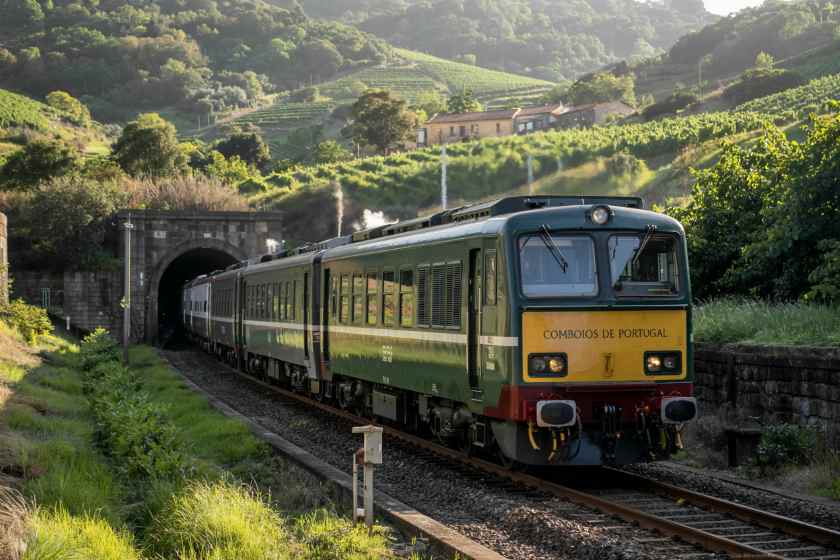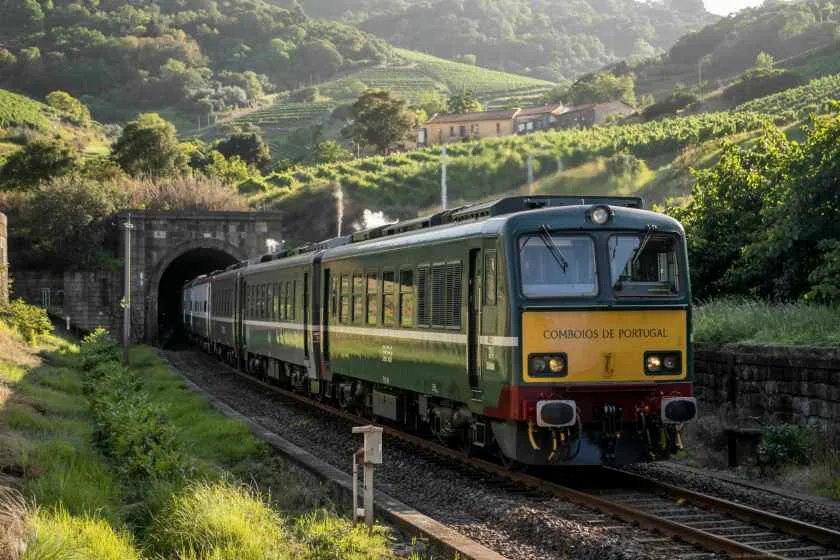Published on
August 23, 2025

Portuguese Trains (CP) has just reached an exciting milestone—over 100 million passengers in the first half of the year! That’s a 9.3% jump from last year and a brand-new record for the railway. This huge increase comes from a few key changes, like the Green Rail Pass, which has really taken off for regional tourism, pushing regional train rides up by 133%.
More people are now choosing trains to discover Portugal’s beautiful cities, stunning coastlines, and rich culture. The Green Rail Pass also leads to greener travel by helping visitors discover the country while using less fossil fuel. Tourists can hop from the Douro Valley’s vineyards to Algarve’s beaches and still feel good about reducing their carbon footprint.
Huge Rail Travel Booms With Tourists, Too
Portugal’s trains have always played a huge role in getting travelers around. They link Lisbon, Porto, and Faro to charming towns, beaches, and quiet villages. Hitting 100 million riders in just six months shows how much travelers value trains to get to all those wonderful places in the country.
The Green Rail Pass has truly changed the game for both Portuguese and international tourists who want to dig deeper into the country beyond the bustling cities. With this simple pass, travelers can hop on and off any train across Portugal’s entire rail network as many times as they like. That means visiting the charming hills of the Alentejo, wandering through tiny, ancient villages, and then wrapping up the day on the stunning Algarve coast— all without the hassle of renting a car.
The jump in train passengers, thanks to the Green Rail Pass, shows that people are eager to see the real Portugal. Instead of sticking to the usual tourist crowds, they are heading to Beira Baixa, the serene Douro Valley, and the sweeping vineyards that few travelers ever see. With fast, regular trains, these secret corners of the country—fields, olive groves, and whitewashed houses—are only a few hours away.
Eco-Friendly Travel that Feels Right
Higher train numbers also fit perfectly into the growing push for more planet-friendly travel. The Green Rail Pass strips away the need for a rental car, cutting down on fuel and carbon emissions. Tourists who care about protecting the environment are finding that train travel gives them a way to leave a lighter footprint while still enjoying every stunning view.
Portugal has earned a spot on the world stage for sustainable tourism, thanks in part to its growing rail network. The new Green Rail Pass, along with other eco-conscious train options, means tourists can get around with a light carbon footprint. As more routes open and greener trains hit the tracks, Portugal strengthens its image as a responsible place to travel.
Better trains also ease the strain on local roads. In Lisbon and Porto, where tourist numbers can jam streets and overfill buses, more train journeys mean less traffic and cleaner air. By nudging visitors onto rail lines, the country makes sure tourism can thrive without hurting the environment or local economies.
Central to this effort is Portuguese Trains (CP). Their network makes visiting the country a breeze. Travelers can hop on a train in Lisbon, zoom north to Porto, or head south to the Algarve in one comfortable ride. These rail links turn the whole country into an easy, car-free playground for guests eager to see Portugal’s gems.
Traveling by train in Portugal is one of the best ways to soak in the country’s stunning landscapes. Picture the ride along the Douro Valley, where steep vineyards climb the hills and the river sparkles beneath the sun. Later, the train might dip toward the Algarve coast, and you’ll see cliffs, sandy beaches, and the ocean stretching to the horizon. These views come to you through wide windows, making the journey itself feel like an extra stop on the trip.
Lisbon and Porto are also easier than ever to visit thanks to improved train links. Direct routes whisk you from one city to the other in just a few hours, meaning you can stroll the colorful streets of Porto in the morning and sip pastel de nata in Belém by the afternoon. Both cities are packed with UNESCO sights, fascinating museums, and vibrant food scenes. With trains running frequently and on time, hopping between them takes just a little more planning than choosing between coffee or tea.
Boosting Local Economies and Regional Tourism
More people are taking the train, and that’s good news for towns outside of Portugal’s major cities. The new high-speed rail lines make it fast and easy for visitors to reach these places, which means they stop at local cafes, stay at small guesthouses, and buy souvenirs made by nearby artisans. That way, spending spreads out instead of concentrating only in Lisbon and Porto, helping workers, farmers, and shop owners in city and countryside alike.
Regions like the Douro Valley and Alentejo are feeling the difference. Both places combine farming with tourism, so when train loads of tourists pour in, local vineyards, olive groves, and riverboat tours see more business. Scenic roads, medieval churches, and taste-of-place wines no longer remain hidden. Local guides, bread makers, and guesthouse owners are not only recording more visitors; they are also dreaming up new tours, experiences, and seasonal fairs that keep the culture—and the economy—growing well beyond the summer peak.
Conclusion
Portugal’s rail network is experiencing remarkable momentum. When more than 100 million passengers rode Portuguese Trains (CP) during the first half of this year, it showed just how much travellers are embracing rail travel. A huge part of that boom has come from the Green Rail Pass, which is bringing visitors to both famous landmarks and lesser-known spots. That, in turn, spreads visitors more evenly around the country, helping small towns and local businesses thrive. Portugal’s ongoing push for green transport ensures that tourists will keep finding both a responsible and delightful way to dive into the country’s rich culture and stunning landscapes.







